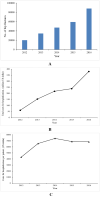Incidence of and trends in hip fracture among adults in urban China: A nationwide retrospective cohort study
- PMID: 32760065
- PMCID: PMC7410202
- DOI: 10.1371/journal.pmed.1003180
Incidence of and trends in hip fracture among adults in urban China: A nationwide retrospective cohort study
Abstract
Background: Hip fracture is a public health concern because of its considerable morbidity, excess mortality, great risk of disability, and high societal healthcare costs. China has the largest population of older people in the world and is experiencing rapid population aging and facing great challenges from an increasing number of hip fractures. However, few studies reported the epidemiology, especially at a national level. We aimed to evaluate trends in hip fracture incidence and associated costs for hospitalization in China.
Methods and findings: We conducted a population-based study using data between 2012 and 2016 from the national databases of Urban Employee Basic Medical Insurance and Urban Resident Basic Medical Insurance in China, covering about 480 million residents. Data from around 102.56 million participants aged 55 years and older during the study period were analyzed. A total of 190,560 incident hip fracture patients (mean age 77.05 years, standard deviation 8.94; 63.99% female) were identified. Primary outcomes included the age- and sex-specific incidences of hip fracture. Associated annual costs for hospitalization were also calculated. Incidence was described as per 100,000 person-years at risk, and 95% confidence intervals were computed assuming a Poisson distribution. Hip fracture incidence overall in China did not increase during the study period despite rapid population aging. Incidence per 100,000 was 180.72 (95% CI 137.16, 224.28; P < 0.001) in 2012 and 177.13 (95% CI 139.93, 214.33; P < 0.001) in 2016 for females, and 121.86 (95% CI 97.30, 146.42; P < 0.001) in 2012 and 99.15 (95% CI 81.31, 116.99; P < 0.001) in 2016 for males. For both sexes, declines in hip fracture incidence were observed in patients aged 65 years and older, although incidence was relatively stable in younger patients. However, the total absolute number of hip fractures in those 55 years and older increased about 4-fold. The total costs for hospitalization showed a steep rise from US$60 million to US$380 million over the study period. Costs for hospitalization per patient increased about 1.59-fold, from US$4,300 in 2012 to US$6,840 in 2016. The main limitation of the study was the unavailability of data on imaging information to adjudicate cases of hip fracture.
Conclusions: Our results show that hip fracture incidence among patients aged 55 and over in China reached a plateau between 2012 and 2016. However, the absolute number of hip fractures and associated medical costs for hospitalization increased rapidly because of population aging.
Conflict of interest statement
The authors have declared that no competing interests exist.
Figures



References
Publication types
MeSH terms
LinkOut - more resources
Full Text Sources
Medical

